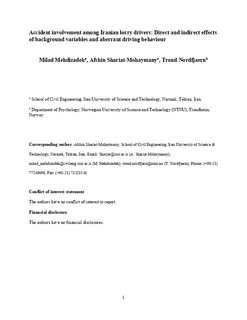| dc.description.abstract | Road accident rates among Iranian lorry drivers are considerably high and, according to empirical evidence, aberrant driving behaviours, summed to certain demographic, psycho-social and work-related factors, may explain their accident involvement. Consequently, the main aim of the study was to examine the direct and indirect effects of background variables (i.e. annual mileage, lorry driving experience, demographic and socioeconomic factors) on accident involvement mediated through aberrant driving behaviour among Iranian lorry drivers. A cross-sectional questionnaire survey was conducted in 2012 among 914 lorry drivers in 10 selected provinces in Iran. The 27-item Driver Behaviour Questionnaire (DBQ) was used to measure aberrant driving behaviour. Results from valid observations (n = 785) confirmed a four-factor solution (including ordinary violations, aggressive violations, errors, and lapses) of the DBQ. Errors, ordinary violations and aggressive violations were positively associated with accident involvement. However, lapses were not significantly associated with accident involvement. The results of structural equation modeling (SEM) further showed that, in addition to direct effects of background variables on accident involvement, several variables had indirect effects mediated by three-DBQ factors; ordinary violations, aggressive violations, and errors. Higher age, having more lorry driving experience, having higher educational attainment, and married drivers were indirectly related to less accident involvement. Annual driving mileage and the resting rate of drivers was both directly and indirectly related to accident involvement. Higher income and car ownership were directly related to fewer accidents. Interventions could aim to decrease ordinary violations, aggressive violations and errors among younger, less educated and single lorry drivers. Initiatives targeted to increase the scheduled resting frequency of lorry drivers may also hold promise. | nb_NO |

